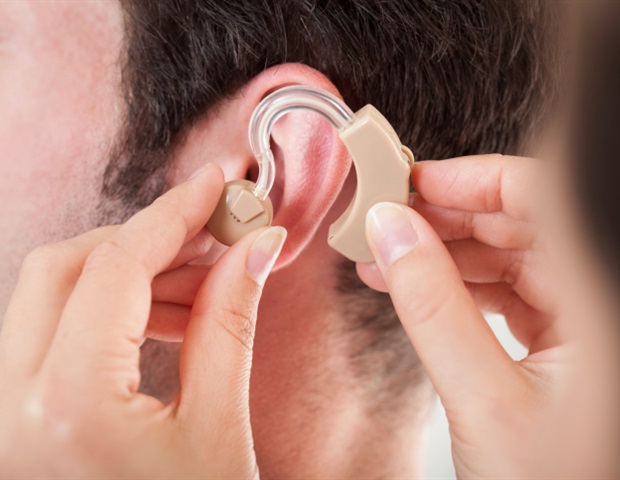
Michael Mosley has spent decades trying to help us all to eat healthily, sleep better and do more exercise. Now the broadcaster, author and former doctor is turning his attention to our ears, encouraging anyone who has noticed a change in their hearing to take a free test. “Hearing change is completely normal and is nothing to be embarrassed or ashamed about,” he stresses. He should know: Mosley has been experiencing hearing loss for several years. “At 66, my hearing’s not great,” he tells me over the phone. “I really struggle in social settings such as pubs and restaurants.” I assume he wears hearing aids these days. “I’m not quite ready for a hearing aid yet!” he protests. “My hearing’s not bad enough. I’ll go back in a year or so for another test.”
This might make Mosley an odd choice to front Specsavers’ hearing-test campaign – but his attitude reflects a society-wide reluctance to wearing hearing aids. And at least he has actually taken a hearing test. A much-cited 2007 study showed that, on average, it takes people 10 years from noticing hearing loss to getting it checked out. Ten years later, another study found the situation has only slightly improved: that figure is now 8.9 years. And Specsavers’ survey of 2,000 UK adults in September found that one in three Britons had noticed changes in their hearing over the past decade but more than half (57%) had taken no action. Reasons given include embarrassment, not feeling it was needed, being too busy and because no one else they know gets their hearing checked. My boyfriend is one of them – he has been struggling to follow conversations in noisy pubs for the past few years, but feels the problem isn’t bad enough to do anything about it.
So does it really matter if you have to ask colleagues to repeat themselves, or turn up the volume on the TV more than you used to, or nod along to half-heard conversations at social gatherings? “There is a lot of evidence that people with untreated hearing loss are at significantly increased risk of depression and anxiety,” says Mosley. Katie Ogden, a hearing-aid dispenser with the maker ReSound, says this is partly because hearing loss can be isolating. “People say to me: ‘I used to love going to the pub on a Friday night – but it’s so difficult to hear, I’ve stopped going.’ Changing your behaviour is a red flag.”
Hearing and balance are connected, sharing a common nerve pathway to the brain, so untreated hearing loss is also linked to an increased risk of falls. One US study found that mild hearing loss tripled the chance of falling in people aged between 40 and 69. And, perhaps most alarming, hearing loss is linked with dementia. A study of 437,704 people published in the Lancet in April found that those with untreated hearing loss were 42% more likely to develop dementia. Those with treated hearing loss were at no increased risk.

The first barrier to treatment is the test itself. “A lot of people are unaware you can get hearing tests for free,” says Mosley. There are lots of online hearing tests, such as one by the charity RNID. GPs can also refer patients for NHS assessments, while large pharmacies and opticians often offer free checks. Many people find the prospect of a test daunting. But, unlike eye tests, there are no wrong or right answers, says Gurleen Brar, an audiologist at Specsavers. “Hearing is subjective and the test is such an easy thing – you simply press a button when you hear a sound,” she says. “Today, I saw someone who was so anxious about taking a test, it had taken her five or six years to pluck up the courage. She kicked herself for not coming earlier.”
Should hearing tests be as routine as eye tests and dental appointments? Brar recommends taking a hearing test every 18 months from the age of 55, or earlier if you have noticed any issues. Boots suggests those over 50 take a test every two years, while the NHS offers a free assessment every three years. Not everyone who has noticed a problem will need to start wearing hearing aids. “You might have a wax buildup,” says Ogden. “But knowledge is power.”
Yet even those diagnosed with hearing loss tend to resist wearing hearing aids. Prof Dongshan Zhu, the lead author of the Lancet dementia study, reported that almost four-fifths of people experiencing hearing loss do not use hearing aids in the UK. In the US, 28.8 million adults could benefit from using hearing aids. Of these, only 30% of over-70s and just 16% of those between 20 and 69 have ever used them. A friend of mine can relate: he was fitted with a hearing aid in one ear in 2015 but has stopped wearing it, despite struggling to hear colleagues every day.
Is there still a stigma around hearing aids? “Absolutely. People remember the big clunky devices,” says Mosley. “And people are embarrassed by hearing loss. There’s a feeling that hearing aids are an obvious sign of being old and decrepit.” But wearing glasses – an obvious sign of poor eyesight – is socially acceptable. Why is it different with hearing aids? “I suppose we almost wholly associate hearing loss with older people, whereas glasses are worn at any age,” he says.
The truth is, hearing loss affects people of all ages. Research shows that approximately 28% of people aged between 16 and 60 in the UK have some form of hearing impairment and could benefit from hearing aids. Furthermore, 1 billion young people globally are at risk of hearing loss from loud music, according to a study last year.
Ogden says that a number of other myths deter people from wearing hearing aids. One is that they feel uncomfortable and are noticeable. In fact, she says, behind-the-ear hearing aids are now sleek and discreet, and in-the-ear aids are invisible. Myth two is that using hearing aids worsens hearing. The truth is the opposite: hearing aids keep the ears and brain stimulated, whereas failing to wear them can result in the brain “forgetting” sounds and losing the ability to process them. A third misconception is that hearing aids make sounds appear robotic. Actually, “Modern hearing aids produce a natural sound and they adapt to background noise,” she says. “They recognise when you’re in a quiet place, and if you move to a busy restaurant, they change how they behave.”
Brar believes any stigma is slowly being broken down. “I’m testing more people in their 30s and 40s now – if I test 10 people in a day, three or four will be under 50,” she says. “And people that age are more willing to wear hearing aids than people in their 60s or 70s.” That rings true. My 80-year-old father huffs that his hearing aids make him look like an old man and rarely wears them; my sister, who recently had hearing aids fitted, is just delighted to hear the customers in the post office where she works.
Brar also credits the Strictly effect: after the actor Rose Ayling-Ellis, who is deaf, won the BBC dancing show in 2021, many new patients mentioned her at their hearing appointments. The singer Rick Astley, who went public about wearing aids last month, may have another positive effect.

Hearing aids don’t “cure” hearing loss, but they can help people to hear more clearly and regain their ability to hear certain sounds. However, many people still struggle with them despite their best efforts. “It’s so, so common to have difficulties with your hearing aid at first,” says Brar. People should have a follow-up appointment to adjust the sound and discuss how the device is working, she says; they may need one or two more appointments to get it right, or to try a different hearing aid. “With any problems, go back and see your audiologist. Nine out of 10 issues can be fixed.”
What if wearers still feel self-conscious? “Any embarrassment is in your head!” says Brar. “People don’t care if you’re wearing hearing aids – they just want you to hear them.” It surely helps that every other person on the street is now wearing headphones or earbuds – there is certainly nothing unusual about having a device in your ear any more. Still, “Perhaps we need some really fancy designers to make hearing aids cool,” suggests Mosley.
“What do you mean?” asks Ogden. “They’re already cool! Hearing aid technology is evolving – just like smartphones. They blow my mind.” She thinks wearers are starting to embrace the things modern hearing aids can do. “People can connect to smart devices and wirelessly stream phone calls to their hearing aid. They can directly link into their laptops for video calls. People see so much benefit, they can’t live without them.” Even some of her most reluctant wearers have been converted, she says. “One man, who really hadn’t wanted hearing aids, came back and told me: ‘I love them – I’ve been showing them to everyone. They’ve changed my life. Why didn’t I do it sooner?’”
Brar agrees that hearing aids can be life-changing. “You can take part in conversations again, go to social events and just enjoy your life,” she says.
She has seen instant benefits. “I recently saw two sisters, one of whom had had untreated hearing loss her whole life. They both cried when she had her hearing aids fitted – it was the first time she could hear her sister clearly.”
Ogden also reports tears and shared “moments of delight”. “People say: ‘I can hear when my other half tells me they love me. I haven’t heard that for years.’” She also receives thanks from partners of those with hearing loss. “They say: ‘You’ve saved my marriage. I couldn’t bear having the TV on so loud any longer!’” Here’s hoping my boyfriend takes note and books a test.
link



:max_bytes(150000):strip_icc()/VWH-GettyImages-2194720794-58e24e56598e43d293793e433166d67f.jpg)

:max_bytes(150000):strip_icc()/Health-Sjogren-horiz-ac9e853c8cb24ccdb236883722aaab6b.jpg)
